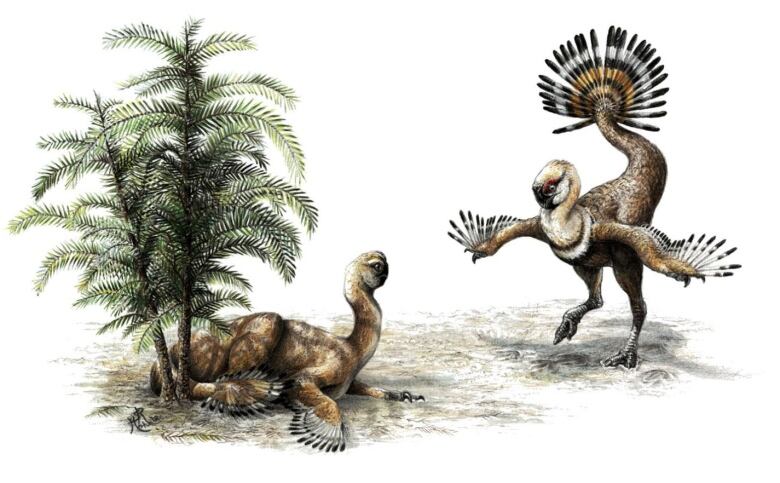Dinosaur researchers reveal how males wooed mates
Alberta study shows oviraptor male's tail was built to flash his feathers and strut his stuff

Romeo and Juliet, two dinosaurs that died tragically side by side millions of years ago, are helping reveal what dinosaur love looked like back in the day.
The fossils of the two turkey-sized oviraptors, nicknamed Romeo and Juliet, lay buried together in the Gobi Desert of Mongolia for 75 million years until being uncovered by paleontologists.
"What we think happened is that these two dinosaurs were nestled together during a downpour of rain and they were trying to find shelter by the side of a great big sand dune," said Scott Persons, a PhD candidate at the University of Alberta who studied the fossils.
The sand dune likely collapsed and buried them alive very quickly and deeply, leaving some well-preserved fossils for paleontologists to find, Persons told CBC's Quirks & Quarks during an interview that airedSaturday.

Oviraptors are distantly related to birds, but couldn't fly. Specimens in China have been found with feathers, including some with beautiful light and dark markings. Some specimens also had fused tail bones similar to those used by birds such as peacocks to support large fans of feathers.

That led Persons and his colleagues to propose that the oviraptor feathers weren't for flying, but were fanned out like the tails of male turkeys or peacocks as part of courtship displays and dances.
- 'Elegant' dinosaurs may have shaken their tail feathers
- Dinosaur feathers likely for sex, not flying
If that were the case, you'd expect to find bigger feathers on males than females and bigger tail muscles to support them.
So Persons and his colleagues examined the tails of Romeo and Juliet to see if they could find any evidence of that.
What they found was that based on the shape of their bones, oviraptor tails had very large muscles for swinging their tails up and down and from side to side.
Romeo, Juliet had different tail bones
And even though Romeo and Juliet appeared to be about the same size and age, Romeo's tail bones were shaped quite differently from Juliet's.

"What this tells us is that Romeo has got a tail that's got even larger muscles responsible for swinging it from side to side," Persons said.
That would have made it possible for him to arch and curve his tail in impressive ways.
"I imagine Romeo in a courtship dance, approaching Juliette, probably right up front, possibly flashing some of the feathers that it also has on its arms, and then waving that tail, maybe raising it up high and then swishing the tail side to side, but posing and really strutting its stuff."
Persons says the discovery may help identify other oviraptors as male or female in different contexts. For example, one skeleton has been found over a nest of eggs. An examination of its tail may reveal whether the father or the mother was keeping those eggs warm, offering new clues about the social lives of those dinosaurs.
It may also reveal where feathers came from, since oviraptors didn't fly and aren't that closely related to the dinosaurs that gave rise to birds, Persons added.
"This tells us that in fact complex feathers first originated not for flight or for gliding, but for socials or sexual displays."
The findings, coauthored by Gregory Funston and Philip Currie at the University of Alberta and Mark Norell at the American Museum of Natural History,were published in the journal Scientific Reports.












_(720p).jpg)


 OFFICIAL HD MUSIC VIDEO.jpg)
.jpg)



























































































